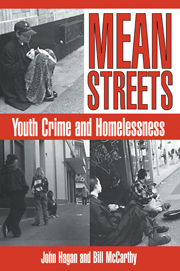Book contents
- Frontmatter
- Contents
- Foreword by James F. Short Jr.
- Acknowledgments
- List of Tables and Illustrations
- 1 Street and School Criminologies
- 2 Street Youth and Street Settings
- 3 Taking to the Streets
- 4 Adversity and Crime on the Street
- 5 The Streets of Two Cities
- 6 Criminal Embeddedness and Criminal Capital
- 7 Street Youth in Street Groups
- 8 Street Crime Amplification
- 9 Leaving the Street
- 10 Street Criminology Redux
- Appendix: The Methodology of Studying Street Youth
- Notes
- References
- Index
4 - Adversity and Crime on the Street
Published online by Cambridge University Press: 06 January 2010
- Frontmatter
- Contents
- Foreword by James F. Short Jr.
- Acknowledgments
- List of Tables and Illustrations
- 1 Street and School Criminologies
- 2 Street Youth and Street Settings
- 3 Taking to the Streets
- 4 Adversity and Crime on the Street
- 5 The Streets of Two Cities
- 6 Criminal Embeddedness and Criminal Capital
- 7 Street Youth in Street Groups
- 8 Street Crime Amplification
- 9 Leaving the Street
- 10 Street Criminology Redux
- Appendix: The Methodology of Studying Street Youth
- Notes
- References
- Index
Summary
In chapter two, we describe the conditions that characterize homelessness and present evidence of the hardships that many youth encounter while living on the street. In Chapter Three, we demonstrate that street youth report disproportionate involvement in serious theft, an activity that we suggest partly follows from their homeless circumstances. In this chapter, we build on these findings. We explore in greater detail the effects of homelessness and argue that the destitution and desperation that characterize street life constitute important foreground class conditions that figure prominently in the genesis of street crime.
We also address a key issue of internal validity noted in the previous chapter. This concern involves the extent to which sampling street youth alone can pose problems in establishing causal processes that lead to crime. There are numerous threats to internal validity (Cook and Campbell, 1979), but the problem of restrictive sampling, or sample selection bias, often is neglected (see Berk, 1983, p. 386). In our research, the issue is whether samples of street youth constitute groups with unique attributes that might bias assessments of causal processes. Since subsequent chapters of this book are based exclusively on analyses of our Toronto and Vancouver street data, it is important to establish that explorations of such samples by themselves can validly reflect causal processes, such as the experience of destitution, that affect youth on the street. In this chapter, we present evidence that this is indeed the case.
Destitution and Crime
The idea that crime is significantly influenced by people's immediate, desperate class circumstances was once a fundamental tenet of criminology.
- Type
- Chapter
- Information
- Mean StreetsYouth Crime and Homelessness, pp. 80 - 104Publisher: Cambridge University PressPrint publication year: 1997

